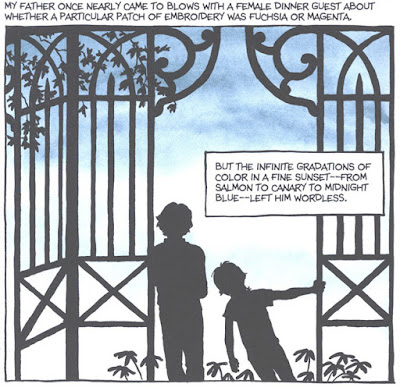In a 2006 interview with The
Believer, Marjane Satrapi, author of the graphic novel Persepolis, discusses her attempt in her portrayal of Iran to
humanize and complicate the common Western stereotypes of Iran, which George W.
Bush had recently dubbed a member of the “Axis of evil.” In discussing her
work, Satrapi says, “Today, the description of the world is always reduced to
yes or no, black or white. Superficial stories. Superhero stories. One side is
the good one. The other one is evil…[but] the world is not about Batman and
Robin fighting the Joker; things are more complicated than that. And nothing is
scarier than the people who try to find easy answers to complicated questions.”
It’s interesting that Satrapi refers specifically to superhero stories in her
response, since this genre of story is intricately linked with comics, her
chosen medium. In a sense, Satrapi seems to be encouraging readers to question
their pre-conceived notions of graphic narratives overall, and to examine
assumptions and stereotypes associated with the format.
It’s interesting to consider some of the works we’ve
examined this semester with an eye to their representations of “good” and
“evil.” In Stitches, for example,
David Small clearly positions himself as a hero, a small child victimized by
the inscrutable and cruel whims of his terrible family, who manages, in the
end, to overcome the wrongs done to him (even, problematically, the genetic
“wrongs” of inherited mental illness). Although Small has the opportunity to
complicate the portrayal of “evil” in his book by considering the impact of
mental illness on his family, or his mother’s unexpressed homosexuality, he
largely glosses over these issues. And his mother’s deathbed tears are similar
to the punishments doled out to villains at the end of many superhero stories
in that they represent, presumably, her awareness of the wrongs she has
committed along with her guilt and regret.
Gilbert Hernandez’s Human
Diastrophism presents a more complex portrayal of “good” and “evil,”
although, on the surface, the story follows a traditional crime narrative
format, as the citizens of Palomar try to solve a cruel series of murders.
Although crime stories often rely on similar didactic representations of right
and wrong, Hernadez complicates this expectation in several ways. While
Tomaso’s motives for killing are not completely clear, the coincidence of his
murders with the sudden onslaught of aggressive monkeys, who are killed by the
townspeople seemingly without concern, suggests a kind of animalism at work in
human nature, implying that murder may even be an aspect of humanity.
Characters such as Doralis and Humberto mimic or resemble monkeys at various
times in the story, further complicating the line between human and animal. Even
the town sheriff accidentally shoots Casimira while killing monkeys,
illustrating that even the act of murder (or protection) might not be easily
classified as villainous or heroic.

